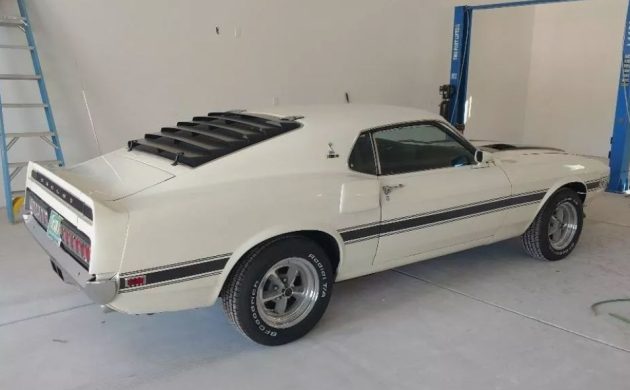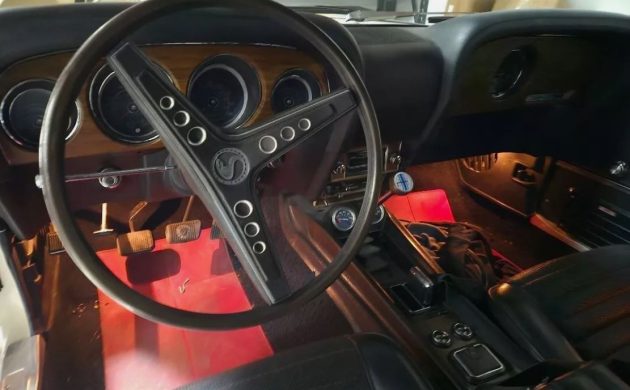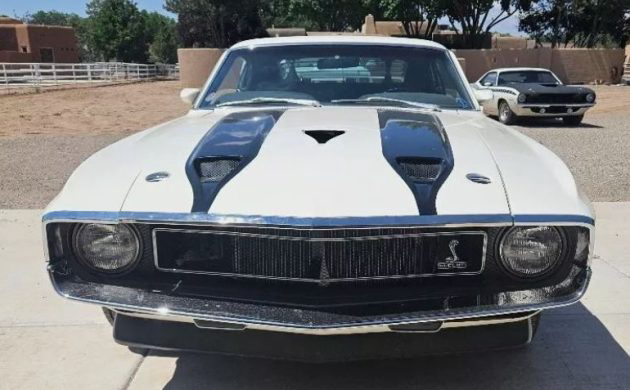Most enthusiasts agree that originality is crucial when assessing the relative worth of any classic. However, some vehicles break that rule merely by wearing the right badge. Take this 1970 Ford Mustang as a prime example. It features modifications that mean it is not a genuine survivor. However, the fact that it features Shelby GT350 badges means that it has generated significant interest since hitting the market. It would be fascinating to know whether those making a play for this classic intend to preserve it in its current form or return it to its factory specifications set out in the included Marti Report.
The First Generation Shelby Mustang era ended in 1970, although the company produced no cars during that model year. Those that emerged were built in 1969, receiving VINs that identified them as 1970 models. There’s a lot to unpack with this GT350, and the Marti Report is an excellent place to start. It confirms that the Wimbledon White paint isn’t original, with the Shelby leaving the factory clad in stunning Black Jade. It is unclear when or why the change occurred, but it undermines any claims that it might be considered a genuine survivor. Reinstating its original shade is possible, but the process would be long, involved, and quite expensive. However, the car is solid, with the exterior and underside shots confirming it is rust-free. The panels are as straight as an arrow, and the gaps are consistent. This GT350 retains its correct Shelby body enhancements and wheels, which are in excellent condition. The first owner ordered it with tinted glass that is spotless.
The waters become more muddy as we delve under the hood of this GT350. It features a 351ci V8, although the seller doesn’t indicate whether it is numbers-matching. It sent 290hp and 395 ft/lbs of torque to the road via a three-speed automatic transmission, with the first owner also selecting a 3.25 Traction-Lok rear end and power assistance for the steering and brakes. Okay, it’s time to draw a deep breath and examine what this car offers potential buyers. The automatic transmission is gone, replaced by a four-speed manual unit. The original radiator left the building as the seller installed an aluminum replacement. However, the most profound changes were made to the engine. It now features aluminum cylinder heads and a new intake and carburetor. The seller added a more aggressive camshaft, new lifters, a new timing chain, a high-flow aluminum water pump, and a Petronix ignition. The changes should increase power and torque, which is rarely a bad thing. If the buyer wishes to reverse the changes, the seller retained the original carburetor and cylinder heads, including them in the sale. They say it runs and drives well, making it a turnkey proposition for the winning bidder.
The interior of this Shelby is the least changed aspect of this classic. It retains the correct Black Clarion Knit trim, roll bar, and harnesses. The first owner ordered the car with an AM/FM stereo radio, but a retro-style stereo occupies its rightful spot. Otherwise, it appears to be as it left the factory. The presentation is excellent, and if the winning bidder elects to return the entire GT350 to its original form, this aspect will require the least work.
This 1970 Ford Shelby Mustang GT350 has attracted nine bids since the seller listed it here on eBay in Albuquerque, New Mexico. That action pushed the price to $50,655, although that figure falls short of the reserve. If it were original and unmolested, a price beyond $80,000 would be there for the taking. However, it isn’t original, and while returning it to its factory form is possible, the color change would make it an expensive process. Therefore, determining its potential value as a modified classic is challenging because cars of that type are typically worth what someone is willing to pay. What do you feel a fair price would be?









To far from original, why would you stuff up a genuine GT350? And why oh why change it from black to white?
If the engine is numbers matching, and you can find a correct date auto, I’d restore it, to how it left the factory.
It’s not a big deal, a lot of highly desirable cars were modified when they weren’t worth much and were readily available. Everyone I knew that wanted a muscle car as was going to modify them as soon as they could, none thought about future restored value. You bought them because them came with the good stuff from the factory and it was easier, often cheaper than buying a base model car and modifying it.
Stock restored muscle cars are fine, but something with period modifications is more interesting. Modified cars were what filled the school parking lots and cruise sites, stock unmodified muscle cars were the rare sight.
Steve R
It wasn’t changed from black to white. The paint code is Black Jade which is a dark green color.
Too bad about the color change. I bet the Black Jade was pretty rare.
I would think it is getting very close to its reserve. Is the trunk lid fully closed? I guess they don’t own a vacuum, and those pedals are mighty dirty. Not the best selection of photos.
I owned a muscle car back in the day which had had a color change. It also had a few “period modifications.” I value stock condition cars the most, and thus I will admit that after owning the car for a time it began to really bug me.
So I sold it and moved on.
The market suggests most people value stock over modified.
It really isn’t what I would call “substantiality modified”.
The most expensive thing is the color change and honestly to value the car 30k below market because it was color changed is kinda nuts.
The automatic and most of the engine mods would be really simple to return. I would keep the Pertronics ignition though, it’s hidden under the distributor cap anyway and much more reliable.
Looks like a great car to enjoy (read drive).
Nice car, mods and all. I wouldn’t have repainted it but in those days it didn’t break the bank account to paint something. Not so these days at the price of paint and labor. After just paying over $200 for a quart of polyurethane I can make a suggestion that repainting it is not worth it.
I like the white color!
I’m not sure I want to know what he’s done to the ‘Cuda
Great car as it is. After a few years, and a few owners, most muscle cars received many day 2 changes anyway. With a detailed pre sale inspection bearing positive results, we’d buy it, leave it as is and drive it. Let the next caretaker make changes.
It all depends on how good the restoration actually was. Too many people have been taken to the cleaners from bad restorations. This car can never be numbers matching without the original transmission. And they don’t show the numbers on the engine either. The cost of a repaint to original is cost prohibitive since it can never be numbers matching anyway. Still a nice car and it would look good in my driveway next to my other 69 Mustangs. $60k tops.
There is nothing wrong with day 2 muscle as long as the modifications are reasonable and not butchered. I have owned multiple muscle cars over the years. There was only one car that was relatively bone stock and I purchased it from a Ford dealer’s used car lot. The car was 13 years old when I purchased it. The ’69 Boss could not pass CA emissions, even though it had all the smog stuff still intact. They had to put on a Holley 600 smog carb to try and get it to pass. It seemed like the techs at that time were a little out of touch with tuning solid lifter motors. That car went back and forth for warranty work several times because it came with a 3 month / 3000-mile warranty. A car like that was rare as hens’ teeth. Today you see far more “original” cars than back in the post muscle car era.
In all the years until the early 2000’s when buying used muscle not one car I came across was remotely close to stock. Most of them had headers and no sign off emission controls. So, seeing this Day 2 Shelby is not a surprise, and it appears to be tastefully done. Here in lies the dilemma it is in the eyes of the beholder. Do they like the color change or not, do you want a 3-pedal car vs. a slush box etc. In my book someone found a Shelby back in the day and performed their own upgrades in what they believed was the ideal car with some nice performance upgrades. If you want something bone stock then move on, if you want something to drive that has far more performance than a stock slush box GT350 this might be your car. The bottom line here is that the value is affected because the market currently dictates stock original cars are more valuable. It is far easier to move what appears to be all original vs. what has been altered and has a questionable pedigree. Hence why true legitimate survivors garner a far higher value.
I have to follow this up with an observation. I have both Ford and GM muscle cars, and I never really understood why there are significantly more Ford guys worried about originality and numbers. Aside from a few select high end Camaros, nearly all the first generation Camaros are in some way modified and still command big dollars, in contrast you have Ford guys worrying about grease pencil marks on the radiator support of a 6 cylinder hardtop mustang.
I think that because early on Mustangs and especially Shelby’s meets had judging based on originality, same with Corvette’s. The owners of those models became hyper focused on that aspect of the hobby. Camaros and Chevy’s, as well as most other makes and models largely escaped that sort of scrutiny.
Steve R
Silly me, here I thought the whole point of getting a muscle car was to have fun and maybe have a reminder of how things used to be. I completely forgot about all those days spent in the high school parking lots and restaurant parking lots going completely bonkers over original hub caps and decal placement. (For those of you with no sense of humor this is a sarcastic post lol)
Mark, I couldn’t agree more. I prefer going to the local drag strip or talk to friends at a swapmeet. My area has too many shady passersby’s to leave the garage door up or work in the driveway. As for car shows, me and some friends were volunteered to help with a car show once, it was a fundraiser for a local high school, the interaction with the participants was so distasteful I haven’t been to a show in the 30+ years since. Better to drive and enjoy it and have fun doing so. If people like shows, that’s good for them, they aren’t for me, just like going to the races or a swapmeet isn’t for everyone either.
Steve R